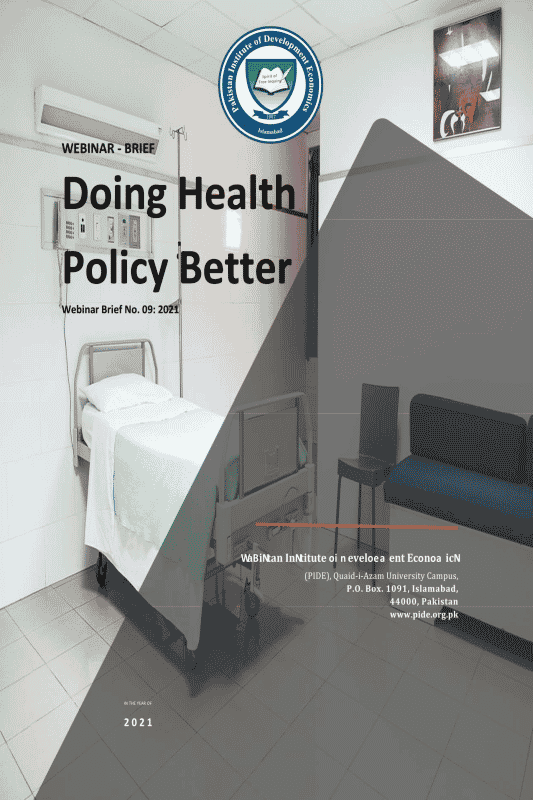Doing Health Policy Better
Publication Year : 2021
Explore More : Webinars Brief
Doing Health Policy Better
To respond to a COVID-19, a reasonably well functioning health services system technically and operationally is essential. In this regard, PIDE organized a webinar to discuss the role of health care systems, its functioning, its effectiveness and related issues based on the system. Further, how can we better the design and health care policies/system?
KEY POINTS.
- Saima Altaf briefed that in order to make the entire system efficient in terms of policy, program design, monitoring and evaluation. For doing so, she briefed it by categorizing in four basis points:
- In almost all countries, personnel has trained to deliver high-end services with respect to the perspective of a specific country. One perspective is that ‘INDIVIDUAL – as a unit of concern’, whereas another perspective is ‘overall SYSTEM – as a unit of concern’.
- Policy makers focus on determining Critical Health Indicator captured the trajectory of the service delivery system and ultimately the results.
- Most of the time, if system itself is healthy, it keeps the individuals healthy and makes it easy to care for those who need medical services. System contains investment in clean water, sanitation, education, housing, nutrition and proactive health services and for this incentivize the service providers to make career choices attractive. This resulted in the form of lesser sick people.
- In terms of individual care, more investment needed in doctors, hospital especially in Pakistan that resulted in poor and wretched results.
- Privatization of Health Care Systems – which seems to be not a good idea. As the entire New York, health care system has privatized and that system is unable to cope up with COVID Pandemic situation. This is just because privatization let the system idle and in emergency resources are not available to the government to deal with.
- Focus on Health Budget – Though it seems to be not very meaningful and helpful in providing health services. The US spends 18% of its GDP on health care, probably the highest in the world and Denmark spends 10% leading to Finland spending 9% of its entire budget. However, their critical indicators are much better than the US. Considering Pakistan, it is adhering only 60% of the allocated budget in this head as un-utilized.
- Local Public Health Delivery System – It is linked with the implementation phase such that administration and management at the community level. Policy established their practices in the local community to develop a holistic health system. It is easy to organize this system by incentivizing the local staff. This could benefit in a way as: –
- Delivering best health care facilities or services, environment health services, health education, to communicate behavior change to the local people especially in disadvantaged areas
- Like in Sri Lanka, Congo, Dharvi Slum outside Mumbai (where only 2000 people had infected from pandemic out of 100,000 population)
- The Pakistan Health Care System is completely unresponsive from so many decades. Pakistan has prioritized the health care of individuals rather than to develop a healthy system. As number of medical colleges, number of medical students and number of hospitals has been increased dramatically over the past 5-6 years but despite of all these facilities, Pakistan is unfortunately doing very little about Continuing Silent Epidemics e.g. Hepatitis, TB, Hypertension, Diabetes. Larger Critical Health indicators have so far been improved e.g. under 5 mortality rate, maternal mortality rate, patients to doctor ratio but still have a status of POOREST in the region. On the contrary, a critical indicator like neo-natal mortality rate is the POOREST in the WHOLE WORLD and has a status of ‘number 1’ since 2018.
- Pakistan is unable to build a local health care system just because of the robust management and administrative system. District Hospitals, Tehsil Hospital, Rural health centers, basic health units can help to provide facilities in far-flung areas but in reality, it does not exist. The need is to start from the very basic level and target the most vulnerable issues related to the health care system. Try to appoint the job on rotation with a proper monitoring and evaluation system. Try to strengthen the already built community-based health care system, just need proper management, monitoring and evaluation. It is better to involve all the stakeholders, especially the specialists of the field, in the policy making process to make it successful, functional and effective for the local people.
- Concluding remarks mainly focus on the fact that the system is heavily suffering from inefficient thought processes in place, lack of ability to configure systemic thinking (heart of policy making), and dearth of ability to negotiate and debate onlong-term policy. Along with that, a very little research was conducted despite the fact that already have established very good research centers. The only hidden reason is to desire to do and administer the system.
© 2024 Pakistan Institute of Development Economics




